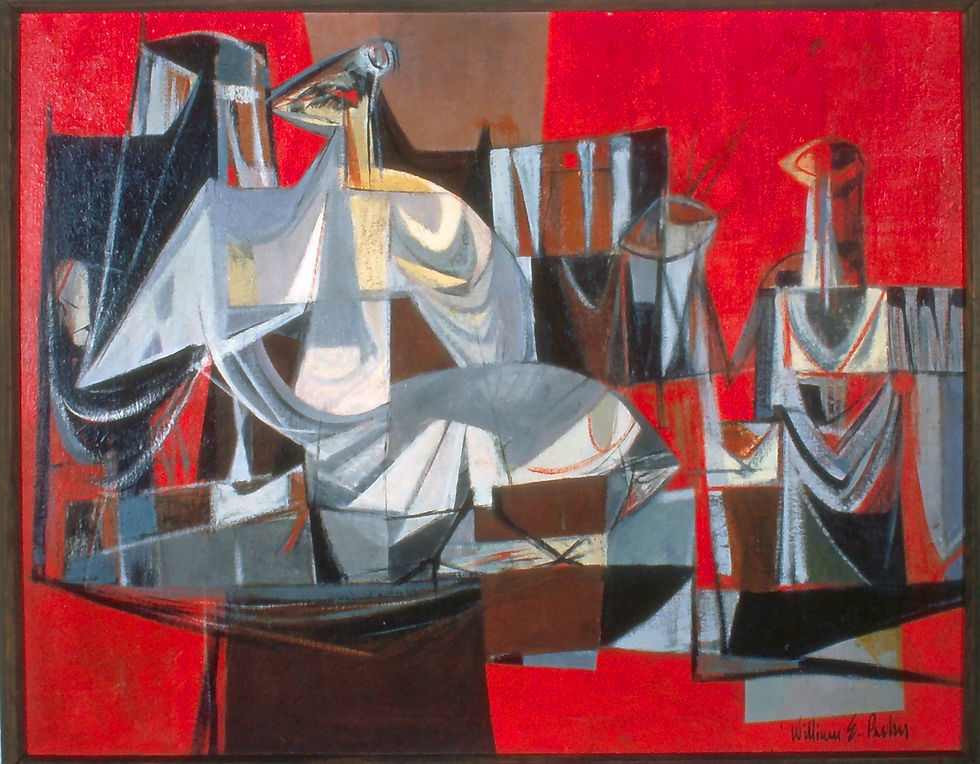William E. Parker
Undergraduate and Post-Graduate Artwork

Oil on canvas, 1.5’ x 2.25’
![Promenade [title uncertain] (1953)](https://static.wixstatic.com/media/8eebbf_1d6f7ff863274f098a4c912328b04ded~mv2.jpg/v1/fill/w_980,h_780,al_c,q_85,usm_0.66_1.00_0.01,enc_avif,quality_auto/8eebbf_1d6f7ff863274f098a4c912328b04ded~mv2.jpg)
Oil on canvas, 2’ x 3.75’

Oil on canvas, 5’ 8" x 4’ 8"

Oil on canvas, 1.5’ x 2.25’
(Double click on the image to view the gallery without interference of arrows and captions)
1953–1954: Undergraduate Work, University of Florida, Gainesville
In comments on the development of his work, Parker notes, “In the broadest sense, I have always been involved with landscape, or, in the earlier work, architectural suggestions in landscapes. After my Undergraduate Period, the landscape theme is apparent in the use of motifs associated with seedpods, botanical forms, rocks, and other natural forms and, later, with symbolic personifications of such themes as in the Rembrandt variations on Saskia and Hendrickje as Flora; in the Bonhoeffer series where flower and garden motifs abound; and in the Teilhard series where pod and leaf and flower-bloom suggestions are the basis for the configurations painted.” Of his undergraduate work from 1953–1954, Parker points out, along with his “early flat pattern efforts” his explorations of “obviously early college art cubism, based on landscape, architectural façade, ship vessel structures, and abstract bird forms against invented architectural settings.” Note that while paintings 1–6 represent an early descriptive approach to landscape, the works thereafter begin to indicate calligraphic elements and spontaneous brushwork that will later appear in the Hendrickje/Saskia, Bonhoeffer, and Chardin series oil paintings and carry into painted elements in the Temperaments photographic works.
1955–1956: Graduate Work, University of Florida, Gainesville. 1956–1960: Early postgraduate work, DeRider, La., and Statesboro, Ga.; one-man exhibition, Cummer Gallery, Jacksonville, Florida.
Parker notes in these works his “use of still-life setups with leaves, rocks, seedpods, and marine and fruit forms as sources for invented landscapes or abstract paintings with invented organizational schemata.” He also recognizes the “distant influence of Arshile Gorky (1904–1948), Lee Gatch (1902 – 1968), William Baziotes (1912–1963), and Rufino Tamayo (1899–1991).” During the period from 1956 to 1959, William Parker spent two years in military service and took his first teaching job at Georgia Southern University in Statesboro. All of his paintings from this period and most of his graduate school work burned in a warehouse fire on his in-laws’ property in Hawthorne, Florida. Very few slides from the period 1955 to early 1959 remain. The works in William Parker’s first one-man exhibition at the Cummer Gallery in Jacksonville represent selections of his major work from 1959 to the late 1960s. These include his early postgraduate paintings with their focused use of organic forms. Works from 1959–60 begin to demonstrate freer brushwork, bolder use of impasto, and a thematic shift based on the artist’s readings of Plato, Mircea Eliade, and, particularly Erich Neumann’s The Great Mother. His specific interest in Phrygian mythology, especially relationship between the “magna mater” in various named personifications (for example, Cybele) and her consort Attis appears in numerous paintings, where, on the basis of my own research, I surmise that the female principle appears as an ovoid ring and Attis as a large “X.” See, for example, ChristoPaganism: An Inclusive Path by Joyce Higginbotham (Minnesota: Llewellyn, 2009): "Speaking metaphorically, then, the X represents the points where what is always changeable and what never changes intersect, the connection point between the heavens . . . and the earth (seasons). Understanding this, we can grasp Plato’s meaning when he says that X represents the divine expressed in the physical world—that is, the point where the earth and heavens meet or cross” (pp. 69–70).
—Catherine-Nevil Parker